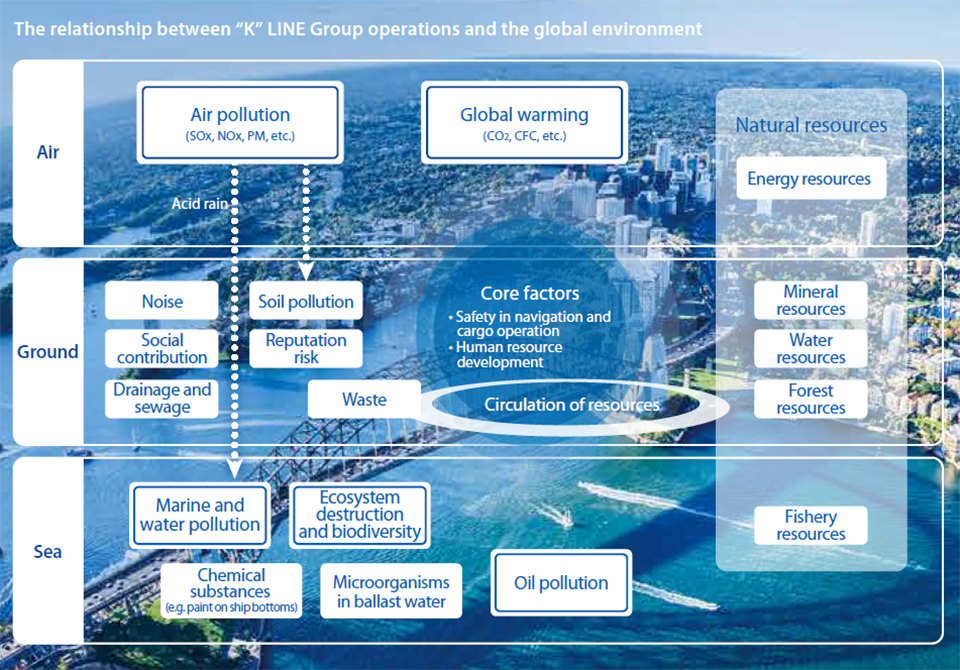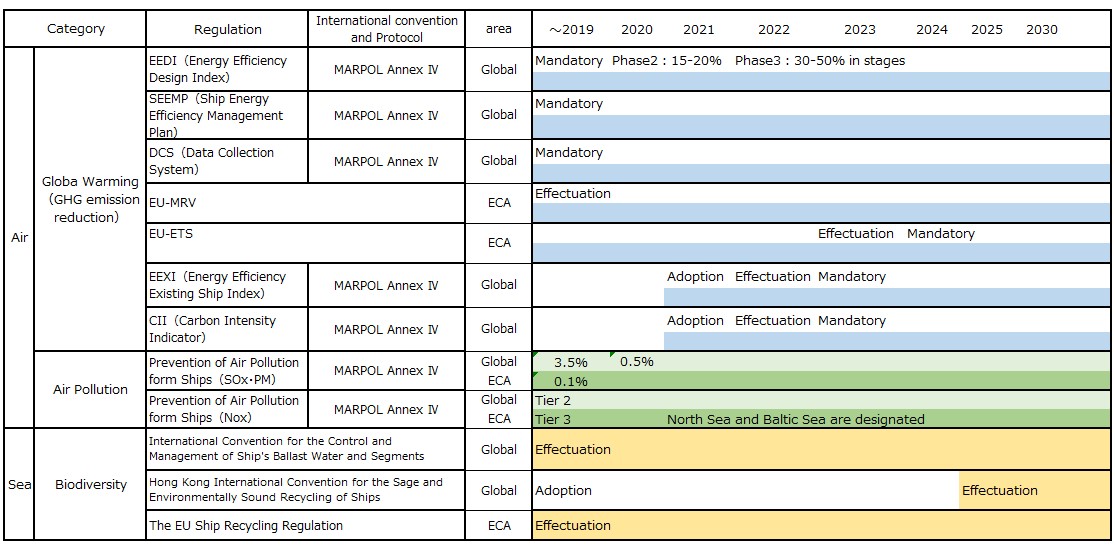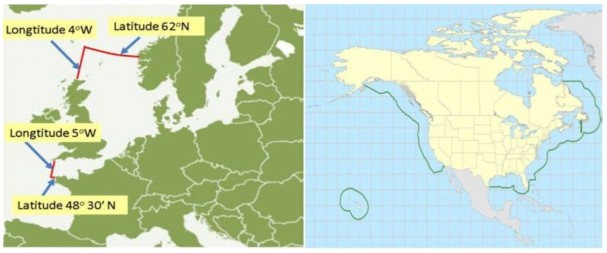Our business activities have some broad impact on the ground, marine and atmospheric environment. For example, operating ships results in emission of air pollutants such as GHG (CO_{2}) which facilitates global warming; SO_{X} and NO_{X} which cause acid rain; and PM which affects human respiratory system adversely.
Besides, a ship is in a very unstable state when she is not loaded with cargo, so we place her into a stable state by taking sea water (ballast water) into the tanks. However, this ballast water can have a major impact on the ecosystem. For example, if ballast water loaded in Japan is discharged at a loading port in Australia, there is a danger that Japanese creatures such as plankton contained in seawater loaded in Japan will damage the Australian ocean ecosystem.
Also, when a ship’s life finishes, her body is disassembled at a facility specializing in scrapping and materials such as iron are recycled. During scrapping, for example, asbestos and other substances harmful to the human body may be contained in the ship; therefore, measures to minimize industrial injuries and environmental pollution (soil contamination, air and water pollutions) in ship recycling are required.

In the shipping industry, various environmental regulations exist to minimize the burden of their business activities on the environment. We are confident that it is the figure that we should aim for to take measures ahead of time shown in ““K” LINE Environmental Vision 2050”, let alone properly recognize and comply with these environmental regulations. Below, we cite factors that can make a particularly large impact (on our lives) among environmental regulations surrounding us, together with their trends.

-
 Enlarged view of the above image
(187KB)
Enlarged view of the above image
(187KB)
Details of environmental regulations in each category are shown below.
Because ships move over all seas of the world, there are many problems that cannot be dealt with by only one country, and international efforts are indispensable. At the International Maritime Organization (IMO), various international conventions and regulations are considered and adopted, and come into effect.
IMO was established in 1958 as a specialized agency of the United Nations to promote international cooperation on maritime affairs, such as ship safety and prevention of marine pollution from ships.
IMO’s “Regulations for the prevention of air pollution from Ships” (MARPOL Annex VI) came into effect in 2005 and thereafter. it was determined that sulfur content concentration in fuel oil gradually be reduced in 2008. Under this regulation, From 2020 and on, we will need measures that either use fuel oil with a sulfur content of less than 0.5% in global operations or to clean the exhaust gas discharged outside the ship with an exhaust gas scrubber.
|
* North America, North America Caribbean Sea, North Sea and Baltic Sea are designated as Emissions Control Areas.

This regulation, which came into force in 2005, aims to reduce NO_{X} emissions from ships. The subject of this regulation is a diesel engine (except one for emergency) whose rated output exceeds 130kw to be installed in newly-built ships. Thereafter, in 2008, it was revised so that regulations would gradually be strengthened from Tier 1 to Tier 3.
Tier 1 (Ships built in 2000~2010) : Set reference line against engine rated speeds.
Tier 2 (Ships built from 2011 and on): Reduce 15.5 - 21.8% compared with Tier 1
Tier 3 (Ships built from 2016 and on): Reduce 80.0% compared with Tier 1 (only ECA*)
*Emission Control Area (ECA): North America and the North American Caribbean are designated at present time, but Baltic Sea and North Sea are also applicable for vessels launched from January 2021.
Please click here to refer to our company’s “Prevention of Air Pollution.”
This is a regulation that came into force in 2013, and in principle, it applies to vessels engaged in international voyages with gross tonnage of 400 tons or more.
EEDI(Energy Efficiency Design Index)
It is defined as the number of grams of CO_{2} emitted when carrying 1 ton of cargo for 1 mile, and DWT (deadweight tonnage) unique to the ship is used for the calculation. Ships cannot be constructed unless the EEDI is below the reference value. Moreover, this reference value differs for each ship type and DWT, and it will gradually be strengthened.
|
*1: Some ships have a reduction rate of 15%.
*2: Currently, the IMO’s sub-committee is considering the introduction of Phase 4 or the advancement of the start of Phase 3 for some ships. Therefore, there is a possibility that the start of Phase 3 will be earlier than 2025 depending on this consideration.
This is a management plan for more effectively implementing measures to improve the energy efficiency of ships during actual operation, such as deceleration operation, selection of optimum routes taking into consideration weather and sea conditions, appropriate maintenance. It is mandatory that it be put onboard.
Please click here for details of the performance management system of our vessel operation.
This is a system for monitoring, reporting and certifying voyage data on actual fuel consumption. It collects voyage data (fuel consumption, navigation distance, navigation time, etc.) for vessels engaged in international voyages with gross tonnage of 5,000 tons or more and came into force in 2018. On January 1, 2019, data collection of target vessels began, and in the following year, we compile the data for one year, which we report to IMO after third-party certification. After that, we keep compiling, certifying and reporting voyage data with CO_{2} emissions every year. IMO is scheduled to discuss establishing a (numerical) target for reducing CO_{2} emissions from international shipping on the basis of the data compiled.
This is a European regulation that came into effect in 2015 and is applicable to vessels with gross tonnage of 5,000 tons or more that call in ports within the EU member country's jurisdiction. This regulation obliges the preparation of a plan (monitor plan) for monitoring fuel consumption, the monitoring of CO_{2} emissions, fuel consumption, navigation distance, operation time and cargo volume per voyage, as well as verification and report of aggregated data of annual CO_{2} emissions started January 1, 2018. Penalties such as forbiddance of port entry and exit in the European region are imposed on vessels violating this system.
EU-ETS is the European GHG Emissions Trading System(ETS)introduced for certain sectors of the economy in 2005. From January 2024, the shipping sector will be applicable as well.
Emission allowances for the shipping sector have no free allocations, and shipping companies are required to purchase EUAs(EU-Allowances)for their emissions on eligible voyages.
Vessels of 5,000 GT or more on voyages into or out of the EU/EEA are subject to the EU-ETS. GHG emissions subject to EU-ETS will be verified under the EU-MRV Regulation. The EU-ETS will initially cover CO2 emissions and be widened to include methane(CH4)and nitrous oxide(N2O)from 2026.
It is an international treaty that stipulates general obligations, applications and violations for the purpose of preventing marine pollution caused by ship navigation and accidents. The treaty aims to prevent pollution of the marine environment by oil, chemicals, toxic substances, sewage, waste and exhaust gas generated from ships. Annex VI: Regulations for the prevention of air pollution from ships.
Green House Gases:Carbon dioxide(CO₂),methane(CH₄), dinitrogen monoxide(N₂O), hydrofluorocarbons(HFCs), perfluorocarbons(PFCs), sulfur hexafluoride(SF₆)and nitrogen trifluoride(NF₃)
As a short-term measure for IMO 2030 GHG emission reduction target, it is a technical approach adopted by MEPC76 in June 2021 to regulate CO2 emissions per ton mile of exsisted vessels. If the EEXI score of the ship does not reach the regulation value, it is necessary to take measures such as limiting the engine output and introducing energy-saving technology.
As a short-term measure for IMO 2030 GHG emission reduction target, it is an operating approach adopted by MEPC76 in June 2021 to evaluate the annual fuel consumption performance. Based on the deviations between the actual score of the vessel calculated from the annual fuel consumption and voyage distance collected on DCS and the standard score, the rating is made on a scale of 5 from A to E.
In order to prevent aquatic organisms contained in ballast water running into other than original habitat sea areas, breeding and adversely affect the ecosystem, In 2017 The International Maritime Organization (IMO) has entered into force “ The International Convention for the Control and Management of Ships’ Ballast Water and Sediments “.
Please click here for the details on our Measures for Preserving Biodiversity.
This convention, which aims to minimize labor accidents and environmental pollution in ship recycling, was adopted by IMO in 2009 and will enter into force 24 months after satisfying the following requirements for entry into force. When this Convention enters into force, maintenance and management of a hazardous materials list is obligatory for ships with gross tonnage of 500 tons or more. Also, unless it is a ship recycling facility approved by a competent authority, it will be impossible to dismantle and recycle ships. This convention will be entered into force on 26th June 2025, because of having achieved the following requirements for entry into force.
The requirements (of the convention) are as follows:
・Number of Parties / requirement : 15 countries or more
・Fleet volume: 40% or more
・Dismantling Volume *: 3% or more
* Total annual dismantling volume in the most recent 10 years by contracting parties.
With this rule adopted in 2013, EU-registered ships cannot be dismantled and recycled unless it is a recycling facility* approved by the European Commission. In addition, this rule requires vessels calling in the EU region regardless of their flag of registry to install the list of hazardous materials in the ship by the end of 2020.
*For the approved recycling facilities, a list has been issued from the EU in December 2016. In this list, facilities for dismantlement in the EU region have been registered. In addition, under this regulation, if you want to dismantle an EU-registered ship after December 31, 2018, it is required to dismantle it at the listed facilities.
Please click here for the details of green recycling at our Company.
